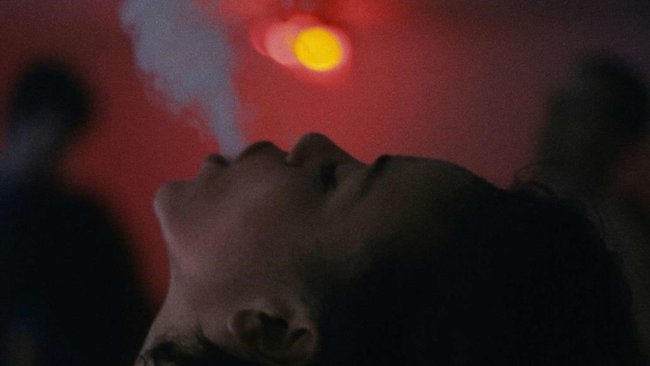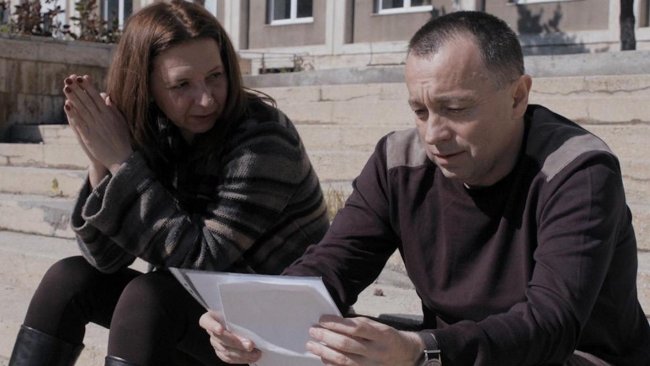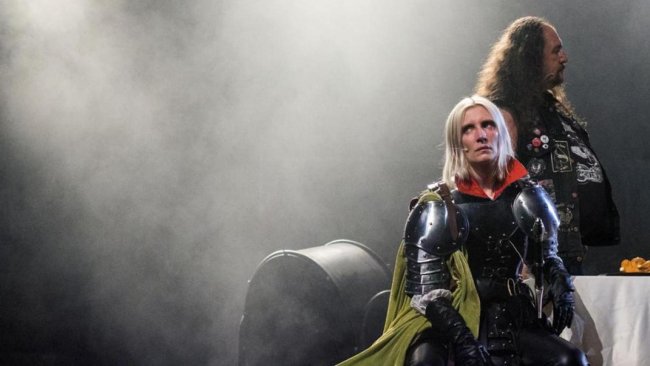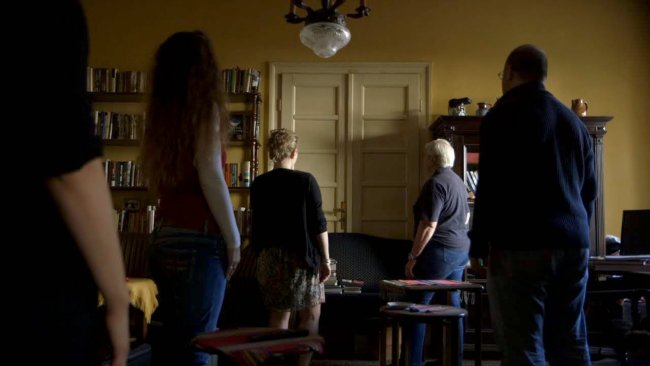Rúnar Rúnarsson | Echo - Bergmàl
[…] D’emblée, les choix esthétiques radicaux sont donnés en partage au spectateur, mis en demeure de tisser un parcours de réflexion et d’émotion à sa mesure. Plans fixes, visibilité de la profondeur de champ, durée épanchée pour distinguer l’enjeu thématique de l’action comme ses mille détails, qui lui confèrent son authenticité par-delà la marque de la mise en scène.
Filmexplorer had the chance to meet Rúnar Rúnarsson in Locarno and discuss with him several aspects of his film.
Text: Pamela Jahn, Jean Perret
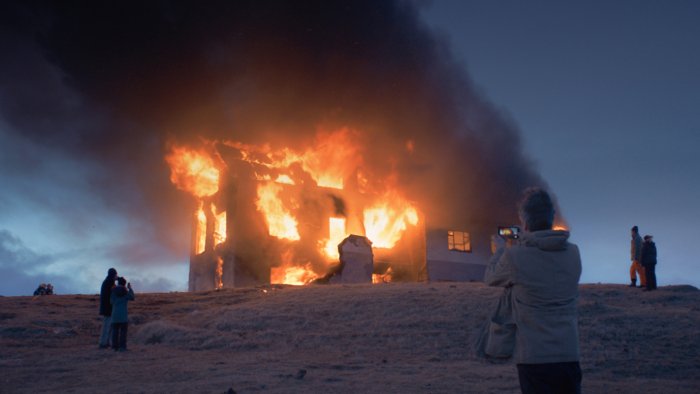
L’ORDRE GÉNÉRAL DU NOËL D’ICI ET D’AILLEURS
Dans le champ, l’ensemble des 400 personnes retenues par Rúnar Rúnarsson pour les 56 plans qui composent Bergmàl ! Chacune engagée à jouer un personnage au plus près de sa personnalité. Être soi-même comme dans un documentaire et jouer comme dans une fiction ! Et c’est dans l’espace rigoureusement délimité des territoires filmés que tout se passe, que rien ne se passe, sinon le déroulement exténuant du temps quotidien.
Le réalisateur islandais, ayant réalisé deux longs métrages, Volcano en 2002 et Sparrows en 2015, revendique la construction d’un récit qui échappe résolument aux actes canoniques de la dramaturgie. La ligne narrative du film est tendue et fragmentaire, composée de micro-récits indépendants les uns des autres, qui à la manière des pièces d’un puzzle font progressivement surgir un tableau d’une densité impressionnante. Le premier plan en impose, qui se révèle être une subtile mise en abîme de l’entier du film. Paysage montagneux enneigé en plan très large : des sauveteurs entrent à gauche et à droite du cadre et avancent en ligne dans la profondeur du terrain. En silence, de plus en plus nombreux, ils pratiquent une espèce de battue, pris dans une recherche dont on ne connaîtra pas l’objet. L’entreprise de Bergmàl – Echo consiste ainsi opiniâtrement en la recherche de marques significatives de l’activité humaine au sens le plus prosaïque de ses états.
D’emblée, les choix esthétiques radicaux sont donnés en partage au spectateur, mis en demeure de tisser un parcours de réflexion et d’émotion à sa mesure. Plans fixes, visibilité de la profondeur de champ, durée épanchée pour distinguer l’enjeu thématique de l’action comme ses mille détails, qui lui confèrent son authenticité par-delà la marque de la mise en scène. Remarquable également est la façon qu’a le cinéaste d’inventer la bonne distance à laquelle filmer les corps et les décors, de leur conférer une présence à leur juste place, celle qui fait sens dans la cohérence finale du film.
C’est le temps de Noël en Islande, minuscule pays du Nord dont on comprend qu’il est à dimension universelle. Fin d’une année et célébration de la nouvelle… Les lieux où s’accomplit la vie au jour le jour, liste non exhaustive : l’église où est déposé le cercueil d’un enfant (est-ce lui que cherchaient les secouristes ?), la piscine pour gymnastique aquatique, le musée ornithologique aux vitrines polies avec soin, le chantier abandonné par des ouvriers grévistes, le tunnel de lavage pour voitures (récurrence du thème de la propreté), embouteillage automobile et vives engueulades, l’émigrant dépaysé au téléphone lointain, les nourritures invendues jetées par chariots entiers, le bûcher de Noël pour grand feu de joie, l’autre feu, celui de la maison sur fond de malversations immobilières, la fête familiale de Noël avec grand-maman portant un casque de réalité virtuelle sur les yeux… Le réalisateur et sa famille font partie de la distribution ! Quelques éclats de dialogues émaillent les rapports sociaux, des voix sont audibles ici et là. Ces mondes sont rendus en des plans-séquences (un oxymore !) chers à André Bazin, qui en inventa l’expression en 1949 à propos du cinéma d’Orson Welles. Frontalement ou obliquement, les prises de vues sont conçues pour densifier le réel et en extraire une architecture signifiante. La réalité est alors rendue à sa pertinence première : le champ se suffit à lui-même et n’appelle aucun hors champ. Il en va d’une mise en scène centripète orchestrée sous contrôle rigoureux et tout à la fois laissée selon le réalisateur à l’improvisation. C’est toute l’attention qui est requise pour prendre la dimension de la banalité obtuse et quotidienne, alors que chaque tableau garde par-devers lui ses énigmes, ses points aveugles.
Ce film, qui prend place dans les gestes les plus contemporains du cinéma actuel, décentre le regard à l’endroit de ce qui fait le lit du mode de vie et ses valeurs établies. Il décentre le centre pour y repérer les parts d’ombres, les dimensions maudites liées aux peurs archaïques, aux solitudes individuelles et collectives. Le film lézarde le gestus de la vie de tous les jours, ses certitudes enkystées et ses bonheurs ripolinés. Il dessille le regard et construit cette évidence qui saute aux yeux, une sorte de vérité : « L’évidence est ce qui fait qu’on ne peut pas voir (ou concevoir) une idée vraie sans que la vérité ne nous en saute aux yeux » (Nicolas Grimaldi). Ainsi s’achève le film, en cette vérité de la proue d’un navire défiant la menace des vagues d’un océan obscur — ne pas sombrer et faire acte de cinéma dans sa possibilité de catharsis.
(Jean Perret)
*
Interview with Rúnar Rúnarsson
Pamela Jahn (PJ): What does Christmas mean to you personally?
Rúnar Rúnarsson (RR): It's a magical time, especially since I became a father, but at the same time, it's a special time in the world. In Western civilization, this is a time of reflection and, in general, we are more observant, and we are more aware. The rest of the year, we are so much faster paced. At Christmas, we are more alert, we are more open, and whether people like the season or not, it's a demanding time for good and worse. Christianity, and religion in general, defines our society. Therefore, also, it's a special time.
(PJ): When did you start working on the project?
(RR): I have been working on this idea about fragments of life for quite some time, and it was when I started thinking in practical terms about how I could make a film this way that I started to move it into the Christmas season. This way, the idea, the fragments came together for me. One of the problems of telling a story like this is that it's hard to sympathise with people that come into one scene and shortly after disappear again. I think having that connection to the Christmas season helps the audience to identify with the situations and the people in front of the camera. Whether they have experienced exactly the same situation, or even if it’s something really foreign to them, it provides an emotional background for everybody.
(PJ): What is it specifically that you think changes people around that particular time of year? Nowadays, it also seems people are much more stressed and vulnerable during Christmas, partly because it's been commercialised so much over time.
(RR): Yes, but nevertheless… you are right, there is so much going on, there's so much that you have to do and there is the social demand that this is supposed to be a good time. The family should be together, everything is hunky dory. If there is a war, people should lay down their weapons and go over the borders and hug. That has happened in world history as well, but all that goes back to people’s awareness, to the fact that you should feel good, and this common knowledge of what this season should be.
(PJ): You have chosen 56 separate segments in the film. Why did you choose this particular number?
(RR): It's just a number. There's nothing cryptic about it. We shot many more scenes. There's no key in the in the number or anything like that.
(PJ): How did you find the episodes you depict in the film? How did you choose which specific moments in people's lives you want to observe?
(RR): I realised something recently that's helped me answer this question - I hadn't realised this before - because in a way, I wanted to make a film about modern society and I come from Iceland. I have some resources there, people that I can rely on, knowledge etc., and I decided to set the film there, as a representation of a Western society, but in answer to your question, what I realised as well is that it’s just a small community. To give you an example that shows you the extremes: I've met the Prime Minister of Iceland, I know his assistant, and I also know one of the three men that are playing monopoly together in the film. I’ve known him for years. So, what this means is that our society is so small, that you know all social layers, and all these social layers interact. There is more and more of a gap between the fortunate and the unfortunate ones, because of wealth and blue colour etc., but when I was a kid, there wasn't this distance. Still, there isn’t the same gap like, for example, in London, or other big cities. It's a small, dense community. The prime minister or somebody that's homeless can be just as close to you and everyone else in between. It wasn't my plan to make a film that shows you the truth of the Icelandic society, or of modern society. It’s echoes. It’s echoes of modern time, but maybe the diversity that is being echoed is a result of the society being so small, so that it connects all social layers, even domestic violence, and all different kinds of things can be very close to you.
(PJ): How much more difficult is it from a director’s point of view and from an editing point of view to tell a story in fragments as opposed to having a conventional plot line?
(RR): At the beginning it felt really liberating, but at the same time, extremely difficult in different ways, because even in “straight forward” stories, you have to evaluate the story now and then to figure out what is fuel for the story and what is not. Here, I soon realised, there was little freedom within that situation, to improvise or to capture real life or some kind of truth about the society we live in. Still, the fact of filming every scene in one single shot on a tripod, and to dictate time, and to have some beauty within the imagery and hopefully, the cinematography, the sound design, the framing and the movement within the frame, all this was coming together and we used it to give some depth to what's being portrayed. I knew it would be a quite a challenge but it really surprised me how tough it was.
(PJ): Did you set yourself rules at the very beginning in terms of the length of the scenes, for example?
(RR): No, the length of the scenes really varies. I’m not sure what the shortest is, maybe 20 or 30 seconds, and the longest scene is four minutes. We shot many other scenes that are not in the film, and of course, I tried to, with my creative team, we tried to make enlightened decisions, but sometimes you shouldn't be too clever, neither should you feel you have to follow your instinct. Sometimes you can't describe your instincts, and generally speaking, in editing or making films from the writing state to the final work, as the director, you never get the same first impressions ever again. It’s important to find this balance that I can’t describe, and to be aware of the first impression, the urge that you felt when you wrote it. Also, if there is something happening in front of the lens, but through the editing process and the sound design, it just doesn't touch you in the same way as when you saw it the first time. There is some kind of magic in that and you shouldn't get tired and throw it away just because you didn't have the same feelings, because you can't have the first impression again. It's just such a really fine balance of not being stubborn and denying progress and, at the same time, preserving something that is pure. It's a funny balance.
(PJ): It is said that documentaries come together during the editing process. It seemed to me that the same might be true for an episode film like this as well.
(RR): Yes and no, because I was going into dark waters with this one, I've never made a film like this before. There's such a big difference in having this scene there or there. It affects everything, but what I was lucky enough to stumble on in film school is to start editing while shooting, to keep an oversight. I come from short films, where it's easier to keep an oversight simply because you might have five days of shooting rather than 20 days. Because the animal is always developing, and to get the best out of it too, you must keep the oversight. It was extremely good, especially for this film, to assemble it throughout the shooting period, but to be completely honest, it was only when I shot the last few scenes that I felt that this would be fine, that it was not just some scattered fragments, but that this was actually fitting well together and that it worked as a whole.
(PJ): Formally and stylistically, you still find a lot of beauty in those images. How important was it for you to have that aesthetic approach as well as a narrative one?
(RR): It's important not only for the sense of beauty – there's never too much beauty in life – but the camera should tell a story as well. If you think about the men in the garage, they are framed within a box, modern men, middle aged men that have been domesticated or something, that are nevertheless acting like they're 16 and trying to be more masculine than they actually are, being put in this box. So, framing them within the box… it's a beautiful frame, but shooting that scene was actually one of the hardest things to do, to make a one scene frame out of it. It looks so effortless when you look at it, but it's so hard to work with just one frame, and if you also want the image to tell something, for example, if you want them to see a metaphor in it or not, people sense those things - unless the metaphor is relating to something like a third century poem that a monk wrote in the alps at that time, that might be a reference that nobody understands - but working with squares, dividing frames, light or different colour palettes, people, even if they are not educated to see those things, they do. They sense something that they can point their finger at – and, hopefully, it has an effect.
This article contains a third-party video. If you would like to watch the video, please adjust your settings.
Watch
ONLINE STREAMING (Switzerland) by Filmexplorer's Choice on cinefile.ch
Info
Echo – Bergmàl | Film | Rúnar Rúnarsson | IS-FR-CH 2019 | 79’ | Locarno Film Festival 2019, Solothurner Filmtage 2020
First published: August 30, 2019
